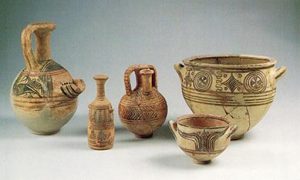
History of pottery: Philistine pottery (compare Mycenaean Greek pottery)
What is pottery?
Pottery is dishes, plates, cups, cooking pots, and storage jars made out of clay. People make dishes and pots out of clay for several reasons. Clay is cheap and easy to get, pretty much anybody can make a useful pot out of it, and you can make it waterproof pretty easily too. It’s relatively easy to clean. Plus it can be made very beautiful, if you know what you are doing. And it is easy to make yours look different from your neighbor’s.
More about clay
And about feldspar
What is kaolin clay?
Mudbrick and baked brick
Who invented pottery?
People first started making pottery out of clay in East Asia, in both China and Japan, around 14,000 BC, long before they started farming. Probably people had always known how to make pottery, but just hadn’t done it much.
Stone Age China
And early Japan
History of baskets
This early pottery was made by just pushing a hole into a ball of clay, or by making a long snake of clay and coiling it up into a pot shape. It may have gotten started by making baskets and coating them with clay. In Japan, early pots might be buried in the ground for storage. One reason for starting to make pottery was to preserve fish. You could ferment the fish it into fish sauce in these buried pots. Another reason might be to store grains like millet.
What is millet?
History of fishing
Pottery in Africa
People in Niger, in West Africa, were making pottery by the 9000s BC. They didn’t know that people were making pottery in China; they invented it on their own. African people may have started to make pottery as a way of storing grain safely. But, like people in Japan, they also used pottery to make fermented fish sauce.
More about West Africa
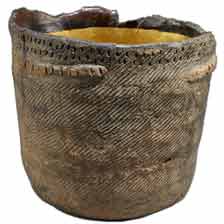
Jomon pottery from Japan with rope impressions (5000 BC, now in the British Museum)
Pottery in the Americas
People probably began to make pottery in the Americas for the same reason, several thousand years later. People who ate a lot of fish and shellfish were making pottery in Brazil about 5500 BC.
Early Brazil
Native Cherokee
Mississippians
Valdivia people
Maybe they also used pottery jars to preserve fish by fermenting it. From Brazil, people gradually began using pottery further north. The fish-eating ancestors of the Cherokee and other Mississippians in what is now Florida and Georgia knew how to make pottery by about 4500 BC. People on the Pacific side of South America started to make pottery about the same time.

Brazilian pottery (500-1200 AD)
Pottery in West Asia and Europe
The use of pottery also spread west from East Asia, reaching Mesopotamia and the Eastern Mediterranean, and then North Africa, around 6000 BC, near the beginning of the Neolithic period there.
Stone Age West Asia
Early North Africa
Neolithic Greece
West Asian people may have started to make pottery as a way to store grain when they started farming. But they also used their pots to make fermented fish sauce. Pottery reached Greece about 5000 BC.
The slow wheel
By around 3000 BC, at the beginning of the Bronze Age, people in West Asia had begun to use the slow potter’s wheel. This is a little platform made of wood that you build the pot on. You can turn the platform around so that instead of having to walk around your pot you can sit still and turn the pot around. In the hands of someone who is good at using it, the slow wheel makes potting a lot faster.
A woman in Mexico digging clay and using a slow wheel to make a pot.
Central American people also invented the slow wheel. The Zapotec were using it to make pottery, maybe by around 100 BC.
Who were the Zapotec?
Who invented the wheel?
The Zapotec kept right on using the slow wheel, but by 2000 BC, almost all potters in Europe, Asia, and North Africa were using the fast wheel instead. The fast wheel is also a platform, but one which spins on an axle, like a top. You can start it spinning with a push or a kick, and then draw the pot gradually out of the lump of clay. This was the first use of a wheel, even before carts had wheels.

Ajax kills himself (Vase by Exekias, ca. 540 BC)
The fast wheel
Using the fast wheel, a good potter can make a pot every minute or so, and all of them almost exactly the same. It’s much faster than coiling or the slow wheel, and so pots got much cheaper than they had been before. To make pottery even cheaper, often the people who made the pots were children (as their small fingerprints show) or enslaved, or enslaved children.
Slavery in West Asia
More about the Yamnaya
The Yamnaya, migrating at this time into Greece and Italy and China, brought the idea of the fast wheel with them to all of those places.
Pottery and identity
From the beginning, people used pottery as a way of constructing their social identity, or showing who they were and how they were different from other people. Many of the designs used on pottery were borrowed from cloth, which was also used to identify people of one group or another.
History of wool
Knotted rugs
Greek pottery is very different from West Asian pottery of the same time, and both of them are different from Egyptian pottery, or Chinese pottery. Etruscan pottery is different too, but similar to Greek pottery in many ways.
Egyptian pottery
Early African pottery
Chinese pottery
Greek pottery
Etruscan pottery
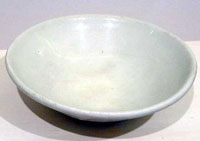
A T’ang Dynasty porcelain bowl
People used clay to make all kinds of things besides dishes: baby baths, high chairs, potty seats, bellows, crucibles, cooking pots, water pipes, and marbles.
The pot bellows
Greek potty seats
What is a crucible?
Clay marbles
When this pottery broke, people used it for all sorts of things: to write on like paper, as voting ballots, for game pieces, to make tile floors or coffins for the dead, as grit to mix with clay and water to make more pottery, to wipe their butts, or to mix with powdered lime and water to make cement.
What is cement?
Writing on pottery
Pottery voting ballots
Broken pottery floors
By this time, pottery was spreading to almost everywhere in the world. Pueblo people in the American south-west started using pottery about 1500 BC, and along the Mississippi valley and the Blackfoot about 200 BC.
Pueblo people
Blackfoot people

African Red Slip pottery
Mold-made pottery
The beginning of the Roman Empire saw some big technological and economic changes in the Western pottery industry. First, people began painting pottery red instead of black. Then they began making it in molds instead of painting it.
Roman pottery
Blown glass
Around the same time, the Phoenicians invented glass-blowing, and this made glass cheap enough to be a serious competitor with pottery. People pretty much stopped making pottery cups, and everyone drank out of glasses. Even a lot of bowls, and little things like perfume containers, were made out of glass.
Also, by about 100 AD, most of the nicer pottery used in the Roman Empire was made in North Africa and shipped by boat as far as Ireland and India.
The Arab invasion of North Africa around 700 AD ended the North African pottery trade, and after that pottery was locally made again for some time in the West, and not very good. Even though the use of pottery was still spreading, reaching Congo in Central Africa by around 900 AD, there were still parts of the world where people relied entirely on baskets: South Africa, Australia, and the Qinook people of North America, the Mapuche in Chile.
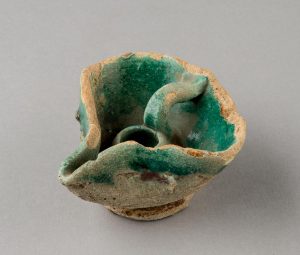
An Islamic oil lamp from the University of Michigan
Porcelain in China
The next great developments in pottery were in Sui Dynasty China, where potters began to make porcelain (PORR-se-lenn) cups and pitchers around 700 AD. This gleaming white pottery was popular not only in China but in West Asia too.
What is porcelain?
Medieval Islamic pottery
But porcelain was very expensive in West Asia, because it had to be carried all the way from China on donkeys and camels, or by boat. So West Asian potters invented lead glazes, which made ordinary pots look white and shiny. This made a kind of imitation porcelain that was a lot cheaper.
Lead-glazed pottery
A little later on, European and Chinese potters began using lead glazes too. About 1200 AD, potters of the Yuan dynasty in China began to use different color glazes to create designs on their pots. Chinese pottery was still the best and the most expensive. So West Asian potters also used these colored glazes to imitate Chinese designs, and Europeans used colored glazes to imitate the West Asian designs.
Learn by doing: make a pot out of clay
More about Chinese pottery
More about Egyptian pottery
Bibliography and further reading about the history of pottery:
The Kids ‘N’ Clay Ceramics Book, by Kevin Nierman (2000). For people who want to throw their own pots. Pretty ambitious.
Fired Up!: Making Pottery in Ancient Times, by Rivka Gonen (1993). Easy reading. Watch out – there are some inaccuracies. Still, it’s the best available history of pottery that’s easy reading.
Ten Thousand Years of Pottery, by Emmanuel Cooper (2000). Not so easy, but a better account. Continues up to modern times.
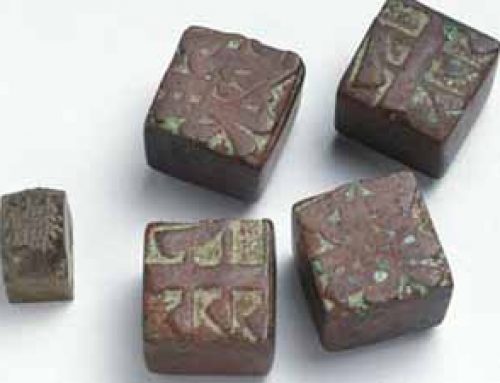


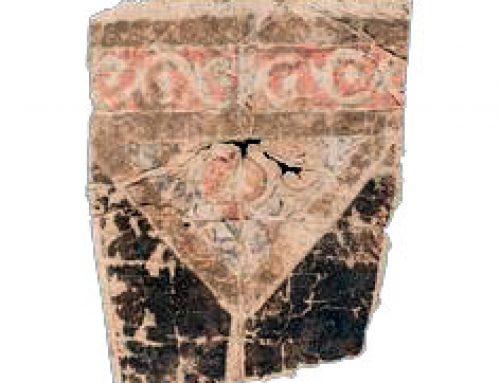

I need assistance as to an old clay pot found in the Sahara , where can I send a pic as I am just an explorer
I’m sorry, but your best bet for that kind of thing is usually a professional antique dealer, rather than an archaeologist. Ask in any antique store near you, and they will recommend an appraiser.
hello my name is z it was very interesting i did pottery class before but i didnt know that it was this cool
Hi! I’m glad you liked it! I think pottery is the best. In fact, I’ve spent a lot of time studying exactly how the Romans made pottery and how they chose what shapes to make.
lol
That citation is not correct MLA format.
You’ll have to change it around to suit your teacher, then.
My name is Sughandis
my name is ligma
Hi, Ligna! Thanks for stopping by.
Thank you for this article. I’m going to reference it in my brownie troop lesson on pottery tomorrow. Much appreciated!
Wonderful! I was a longtime Girl Scout myself and I’m very happy to hear I could help out another Scout.
HI MY NAME IS BOB
Hi Bob.
my names is jeff
Hi Jeff! Thanks for stopping by!